Inside Story Protocol: The Layered Architecture Powering On-Chain IP
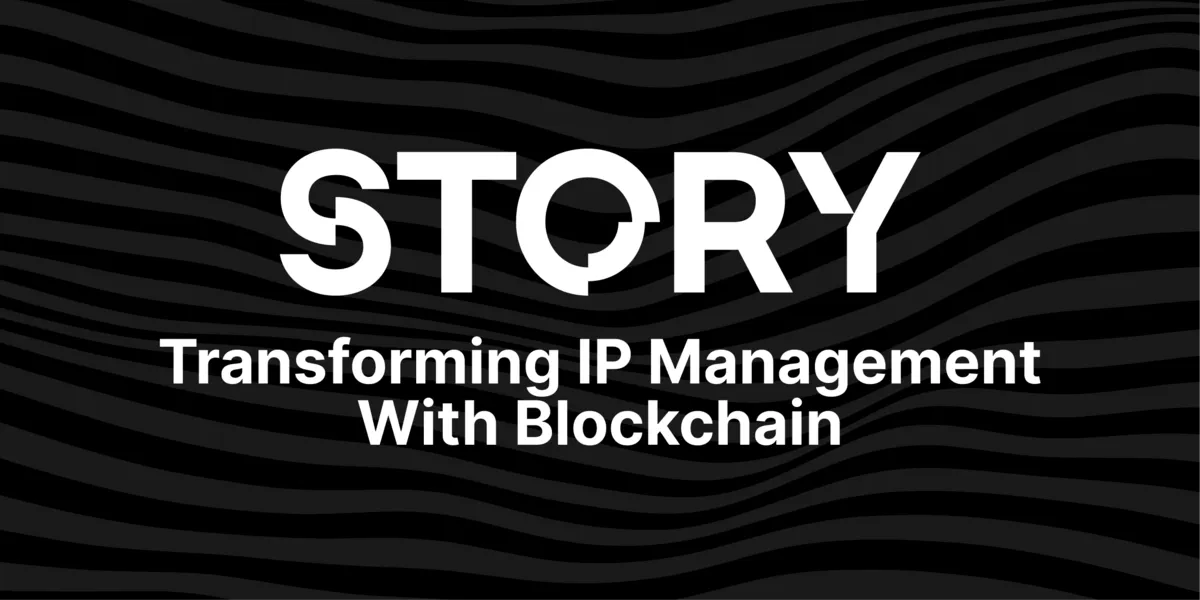
The emergence of blockchain technology has redefined many industries, yet one of the most transformative shifts is happening in intellectual property (IP) management. Traditionally, IP ownership has been fragmented, costly to enforce, and prone to disputes. Story Protocol, a pioneering blockchain-based solution, seeks to automate, decentralize, and globalize IP management, ushering in a borderless and automated IP economy.
At the heart of Story Protocol’s revolutionary model lies its architectural framework, a multilayered system designed to handle the complexities of IP registration, licensing, attribution, and monetization in a decentralized manner. This framework ensures efficiency, security, and transparency, making IP truly programmable.
Understanding this architecture is key to grasping how Story Protocol facilitates a decentralized ecosystem where creators, developers, and businesses can collaborate freely while preserving their rights. This article explores the layered technical structure of Story Protocol, providing a deep dive into its core components and their respective roles.
The Layered Architecture of Story Protocol
The architecture of Story is structured into three fundamental layers: execution, storage, and consensus. Each layer serves a specific role, ensuring that the network remains efficient, secure, and extensible. By following a modular approach, Story optimizes the handling of intellectual property as a unique asset class while maintaining compatibility with existing blockchain ecosystems.
At the heart of Story’s computational capabilities lies the Execution Layer, a multi-core system that ensures flexibility and specialization. Unlike monolithic blockchain designs that struggle with scaling complex applications, Story employs a main execution core alongside multiple specialized cores, each optimized for distinct tasks.
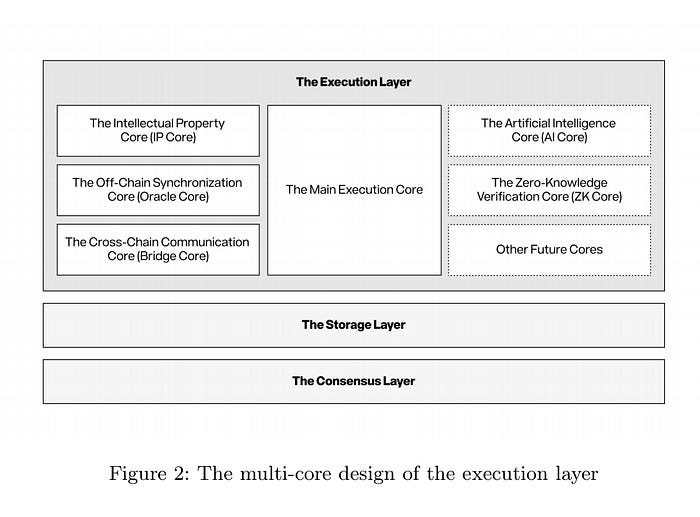
The main core provides Ethereum Virtual Machine (EVM) equivalence, ensuring that existing smart contracts can seamlessly integrate with Story. This enables rapid adoption by developers familiar with Ethereum’s ecosystem. The specialized cores, on the other hand, cater to advanced use cases that cannot be efficiently handled by general-purpose execution environments.
Also Read: MORSE: Redefining Digital Companions Through DN404
The Intellectual Property (IP) Core
The Intellectual Property (IP) Core is a defining innovation of Story’s architecture, as it transforms IP into a first-class blockchain asset. Within this core, IP assets are structured as graph-based entities, where nodes represent assets and edges encode their economic and legal relationships. This facilitates composability, allowing derivative works to inherit revenue streams from their predecessors. The Proof of Creativity (PoC) protocol, natively embedded in this core, serves as both an open IP repository and a framework for defining licensing, royalties, and compliance rules.
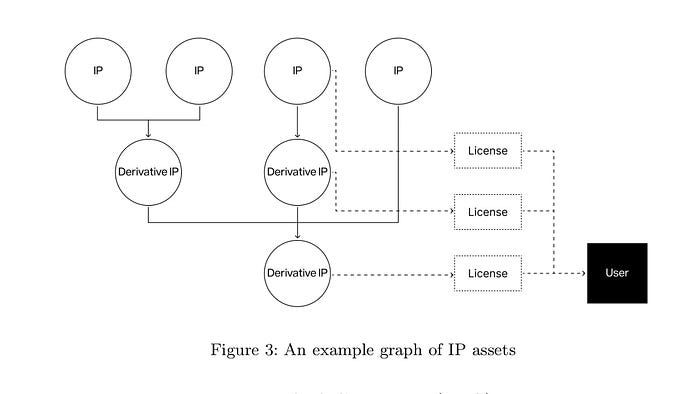
Offchain Synchronization Core
The Offchain Synchronization Core extends the protocol’s functionality beyond on-chain environments by integrating oracles and real-world attestations. This core bridges blockchain-native IP with traditional legal frameworks, verifying off-chain payments, social identities, and contract execution. It plays a crucial role in ensuring that intellectual property registered on Story remains enforceable in legal jurisdictions.
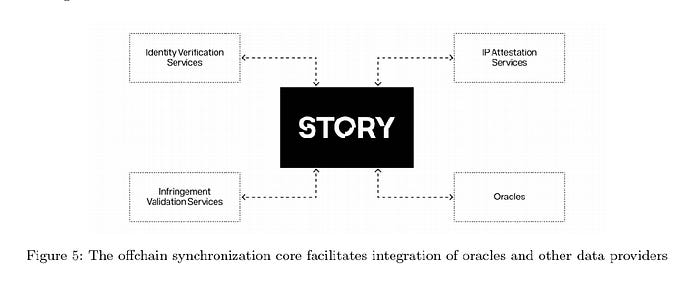
A Cross-Chain Communication Core
A Cross-Chain Communication Core ensures that IP assets can seamlessly interact with other blockchain ecosystems. This core leverages protocols such as Inter-Blockchain Communication (IBC) to enable IP licensing, collateralization, and monetization across diverse platforms. By eliminating value segmentation, Story enhances the liquidity and interoperability of IP assets, ensuring that creators can engage with decentralized finance (DeFi) applications, NFT marketplaces, and other blockchain services without restrictions.
Also Read: How to Add Liquidity to Mitosis Vaults and Support Ecosystem-Owned Liquidity (EOL)
Optimized Storage and Data Management
To support the complex data structures associated with intellectual property, Story implements an advanced Storage Layer that optimizes data placement across heterogeneous storage systems. Inspired by Flash Translation Layers (FTL) used in NAND memory, this layer dynamically allocates data based on access frequency, size, and durability requirements. Given the diverse nature of IP assets (ranging from small text-based patents to large multimedia files and machine learning models), this intelligent storage mechanism is essential for maintaining efficiency.
A key innovation within the Storage Layer is its integration of both on-chain and off-chain storage solutions. While essential metadata and cryptographic commitments are stored on-chain for immutability, bulk data such as AI model weights and high-resolution media are distributed across IPFS (InterPlanetary File System) and Arweave, ensuring decentralized permanence. This hybrid approach balances cost and accessibility, preventing unnecessary blockchain bloat while maintaining verifiable authenticity.
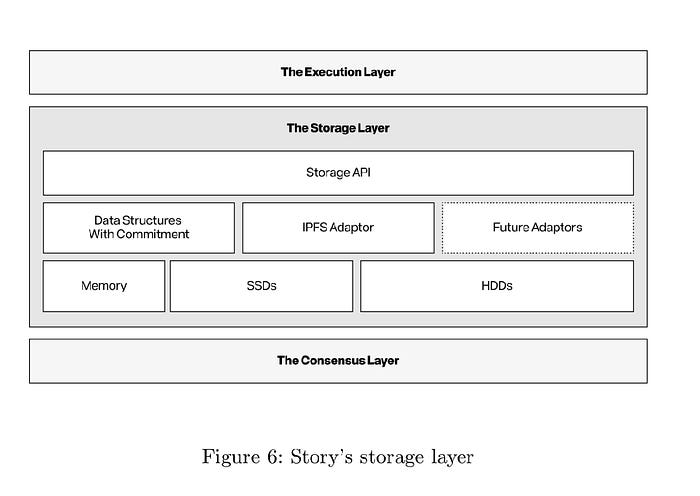
Moreover, Story enhances user experience by providing a unified storage interface, allowing applications to seamlessly interact with different storage layers without requiring complex integrations. This abstraction shields users from the technical intricacies of decentralized storage and ensures deterministic behavior across all IP transactions.
Security and Consensus for a Trustless IP Network
At the foundation of Story’s architecture lies the Consensus Layer, responsible for ensuring the network’s security, integrity, and stability. Given the economic value embedded within IP assets, this layer must provide instant finality, fault tolerance, and high performance. Story employs CometBFT (a modern implementation of Tendermint’s Byzantine Fault Tolerant consensus algorithm) to achieve these properties.
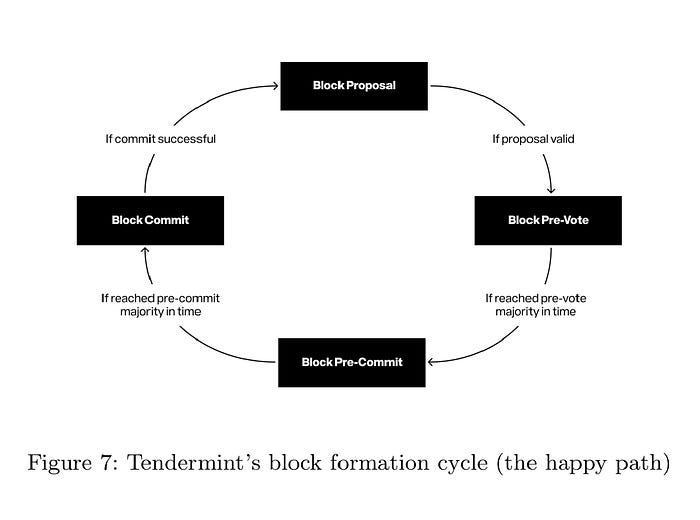
A key advantage of this consensus mechanism is its instant finality, ensuring that once an IP transaction is recorded on the blockchain, it is irreversible. This is crucial for maintaining legal enforceability in licensing agreements and royalty distributions. Additionally, Proof-of-Stake (PoS) secures the network, with validators staking Story’s native token (IP) as collateral. This economic model incentivizes honest participation, as malicious behavior leads to financial penalties.
Also Read: Theo Campaign: Mitosis Strategic Vault Play for Yield, Loyalty, and Long-Term Growth
To further enhance security, Story introduces a programmable dispute resolution mechanism within the PoC protocol. If an IP asset’s legitimacy is challenged, validators and off-chain arbitration entities can engage in a decentralized resolution process, ensuring that fraudulent registrations do not undermine the network’s credibility.
Intellectual Property as a Programmable Asset Class
Story’s architecture is designed to make intellectual property programmable, composable, and liquid. Unlike traditional IP systems, where rights and royalties are static, Story allows IP assets to be dynamically extended, monetized, and traded. This is facilitated by a modular smart contract framework, where different modules define how IP interacts with the network.
The Licensing Module allows IP holders to tokenize licenses as License Tokens, specifying usage terms such as commercialization rights, transferability, and royalty percentages. This introduces automation to a historically cumbersome process, enabling creators to monetize their work with minimal friction.
A Royalty Module automates revenue distribution across the intellectual property graph. When a derivative work generates income, a predefined percentage is routed to parent assets, ensuring that contributors across the creative chain are compensated. This economic model not only promotes collaboration but also transforms IP into a yield-generating asset class.
The Dispute Module ensures that IP transactions remain enforceable. In cases of infringement or disputes, an arbitration system evaluates claims, imposes penalties, and maintains the integrity of the network. By embedding legal mechanisms into the blockchain itself, Story reduces reliance on traditional court systems while preserving enforceability.
Enabling Autonomous AI and Agentic Commerce
One of the most forward-looking aspects of Story’s architecture is its alignment with artificial intelligence. Given that AI models are both consumers and producers of intellectual property, Story acts as a foundational settlement layer for AI transactions. Machine learning models, datasets, and fine-tuning algorithms can be registered as IP assets, with revenue streams distributed based on their usage.
A Chain of Intelligence emerges within this framework, where datasets fuel model training, models contribute to fine-tuned derivatives, and economic value flows across the entire pipeline. Techniques such as model fingerprinting (e.g., Open Monetizable Learning, OML) ensure that AI-generated assets maintain provenance and attribution.
Furthermore, Story introduces Agent TCP/IP, a protocol designed to facilitate agent-to-agent transactions in a trustless manner. In this paradigm, autonomous AI agents negotiate, license, and monetize intellectual property without human intermediaries. This enables AI to act as economic participants, exchanging knowledge, creative assets, and services autonomously while adhering to predefined contractual terms.
Also Read: Earning MITO Points: Strategies for Maximizing Airdrop Rewards
IP Token
The IP token serves as the backbone of Story’s peer-to-peer intellectual property network, facilitating transactions, securing the blockchain through staking, and enabling the monetization of creative assets. Every IP asset registered on Story is programmable, allowing creators to define licensing terms and royalties that are enforced via smart contracts. When a derivative work is monetized, a portion of the revenue is automatically distributed to the original creator through the Royalty Vault, ensuring fair compensation across the network.
Beyond licensing, the IP token integrates into decentralized finance (DeFi) applications, allowing intellectual property to be staked, fractionalized, or used as collateral. AI agents operating on Story can autonomously license datasets and fine-tuned models using IP tokens, creating a dynamic economy where artificial intelligence contributes to and benefits from the network. The token also plays a fundamental role in governance, potentially granting holders the ability to influence protocol upgrades and economic policies.
Story’s Proof-of-Stake consensus model relies on validators staking IP tokens to secure the network, earning rewards in return. This mechanism ensures network integrity while creating long-term economic incentives. As Story evolves, the IP token could underpin a new financial system for knowledge, making intellectual property a liquid and programmable asset class.
Also Read: Cross-Chain Liquidity Management: Unifying DeFi with Mitosis
Conclusion
The architecture of Story is not merely an incremental improvement to existing IP systems; it is a reimagination of how knowledge and creativity can be structured, exchanged, and valued. By integrating a multi-core execution environment, optimized storage solutions, and a secure consensus framework, Story creates a programmable market for intelligence. Intellectual property is transformed from a bureaucratic asset class into a fluid, composable, and revenue-generating ecosystem.
As artificial intelligence accelerates the pace of idea generation, Story ensures that attribution, monetization, and collaboration remain integral to the creative process. Just as Bitcoin serves as the store of value for commodities, Story aspires to be the store of value for human intelligence, enabling a world where knowledge is both decentralized and economically productive.
The IP Token plays a crucial role in this ecosystem, facilitating seamless transactions, incentivizing innovation, and ensuring that creators retain control and value over their intellectual contributions. Through the IP Token, Story redefines the economics of ideas, turning knowledge into a liquid, tradeable, and compounding asset.
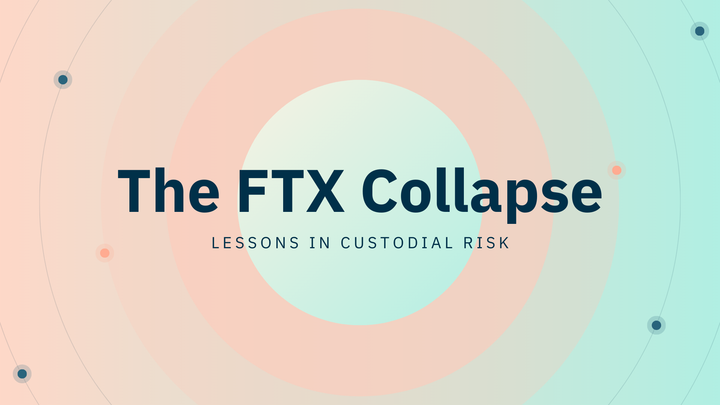

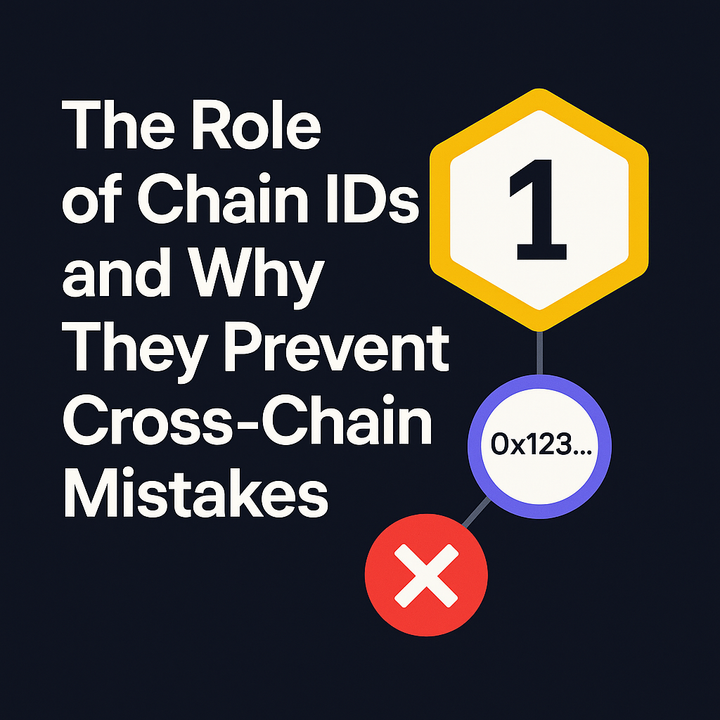
Comments ()